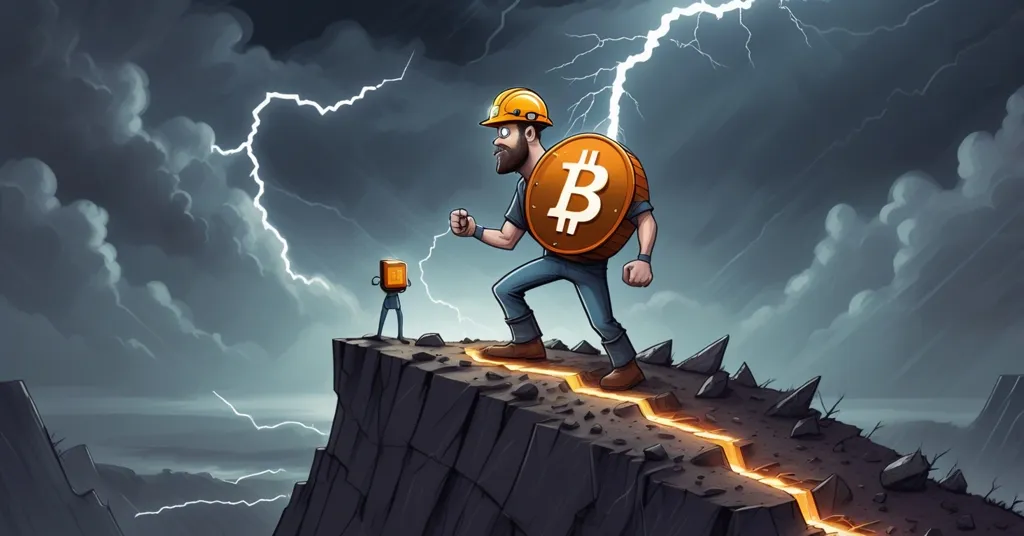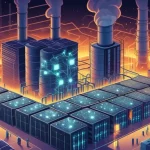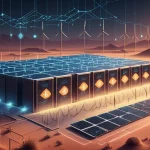MARA CEO: Bitcoin Miners Risk Extinction by 2028 Halving Without Power Control

MARA CEO Warns: Bitcoin Miners Face Extinction Without Power Control by 2028 Halving
Fred Thiel, CEO of MARA, a titan in the Bitcoin mining arena, has issued a dire warning to the industry: secure your own power or prepare to vanish. With skyrocketing energy costs, cutthroat competition, and the ominous 2028 Bitcoin halving on the horizon, Thiel insists that miners must break free from grid dependency to survive the coming storm.
- Energy Crunch: Soaring costs and grid reliance are strangling Bitcoin mining profitability.
- 2028 Halving: Block rewards will plummet to 1.5 BTC, threatening operations without major price or fee jumps.
- Power Autonomy: Miners must generate their own energy or forge ties with providers to stay afloat.
The Energy Crisis Squeezing Bitcoin Miners
Bitcoin mining has transformed from a basement hobby with a few graphics cards into a ruthless, industrial-scale battleground. Margins are now wafer-thin, and the stakes couldn’t be higher. Fred Thiel of MARA describes this landscape as a zero-sum grind—every new miner, every additional terahash of computational power, chips away at everyone else’s share of the pie. For those unfamiliar, terahash refers to the speed of mining hardware, measuring trillions of calculations per second. The global hashrate—a gauge of total computational power securing the Bitcoin network—keeps soaring, tightening the noose on profits as more players vie for the same fixed rewards. And the core issue fueling this brutal competition? Energy. It’s not just a cost; it’s the biggest expense and the ultimate decider of who thrives and who tanks.
Thiel doesn’t sugarcoat the harsh reality facing miners tethered to expensive grid power. If you’re shelling out premium rates for electricity, you’re already a sitting duck in a power price storm. “By 2028, you’ll either need to generate power yourself, be owned by a power generator, or team up with one. The time for being a miner connected directly to the grid is running out,” he cautions, as highlighted in a recent discussion on the future of mining shared by MARA’s CEO. MARA’s own playbook is all about staying in the lowest 25% of production costs, a cutthroat strategy to outlast three-quarters of their rivals when the shakeout inevitably hits. It’s survival of the cheapest in this game, and energy costs in crypto mining are the battlefield.
“By 2028, you’ll either need to generate power yourself, be owned by a power generator, or team up with one. The time for being a miner connected directly to the grid is running out.” – Fred Thiel
2028 Halving: A Ticking Time Bomb for Profitability
For those new to Bitcoin, mining is the process of validating transactions on the blockchain by cracking complex mathematical puzzles using specialized hardware known as ASICs (Application-Specific Integrated Circuits). Miners earn newly created Bitcoin, called block rewards, plus transaction fees paid by users sending BTC. But here’s the kicker: roughly every four years, the Bitcoin protocol triggers a halving event, slashing the block reward by 50%. This mechanism, baked into Bitcoin’s code by its mysterious creator Satoshi Nakamoto, caps the total supply at 21 million coins to ensure scarcity. The next major halving, slated for 2028, will cut rewards to just 1.5 BTC per block, down from the current 3.125 BTC post-2024 halving. That’s a devastating drop, and Thiel warns that without a massive leap in Bitcoin’s price or a surge in transaction fees, many miners will bleed red.
Looking back, past halvings offer a sobering lesson. After the 2020 halving, miners faced a 50% revenue hit until Bitcoin’s price doubled by late 2021, bailing out the survivors. Thiel projects an even grimmer outlook for the future, estimating that Bitcoin mining profitability hinges on the cryptocurrency appreciating by at least 50% each year. Without that kind of relentless growth, the numbers simply won’t add up for most operations by 2028, and things look even bleaker by the 2032 halving.
“If Bitcoin does not increase by 50% or more each year, it will become challenging after 2028 and considerably tougher in 2032.” – Fred Thiel
Transaction fees are supposed to bridge the gap as block rewards shrink. When you send Bitcoin, you attach a small fee to incentivize miners to confirm your transaction faster. But the current reality is stark: fees aren’t keeping pace. Even temporary spikes driven by novelties like Ordinals and inscriptions—methods to embed data such as NFTs directly on Bitcoin’s blockchain—haven’t provided a lasting lifeline. Bitcoin’s design banks on mass adoption driving up fee revenue over time, but we’re nowhere near the scale needed. If you’re a miner pinning hopes on fees to salvage your operation post-2028, you might be in for a brutal wake-up call. Even promising layer-2 solutions like the Lightning Network, which acts like a side road to reduce congestion on Bitcoin’s main highway by handling smaller transactions off-chain, are a slow burn rather than an immediate fix.
Strategies for Survival: Diversification and Power Control
While the 2028 halving looms as a financial earthquake set to shake out the weak, the root of the crisis lies in energy—a cost miners can’t dodge. So, how are companies adapting to these savage conditions? Some are pivoting with bold diversification. Firms like Hut 8 have ventured into artificial intelligence (AI) and high-performance computing (HPC), leveraging their existing infrastructure of powerful servers and cooling systems. AI workloads, for instance, often yield higher margins than Bitcoin mining during bear markets, offering a crucial financial cushion. It’s a smart hedge for those with the capital to pivot, turning mining rigs into dual-purpose cash cows.
Others, like MARA, are doubling down on vertical integration—controlling every link in the chain, from owning cutting-edge hardware to generating the electricity that fuels it, all to slash costs and cut reliance on external providers. Thiel also points out a bizarre twist in the market: even hardware suppliers are jumping into mining themselves as demand for new equipment wanes. “You have hardware suppliers running their own mining businesses since customers are not buying as much equipment,” he notes. Your supplier today could be your rival tomorrow, adding yet another layer of ruthless competition.
“You have hardware suppliers running their own mining businesses since customers are not buying as much equipment.” – Fred Thiel
Energy independence, however, remains the linchpin of Thiel’s vision for the future of Bitcoin mining. Relying on grid power is fast becoming a death knell as costs spiral and environmental backlash intensifies. Bitcoin’s energy consumption, often likened to that of small nations, has drawn sharp criticism from regulators and activists. Miners unable to lock in cheap, reliable power are getting obliterated. Some are striking partnerships with energy providers, while others are going fully off-grid, setting up near renewable sources. Take Riot Blockchain, for example, tapping wind power in Texas, or Bitfarms striking hydroelectric deals in Canada, cutting energy expenses by as much as 60% compared to grid rates. Even Tether, better known for its USDT stablecoin, runs mining operations at near-zero cost, piling on competitive pressure. Renewable energy in Bitcoin mining isn’t just a PR move—it’s a survival tactic.
The Bigger Picture: Centralization vs. Innovation
Now, let’s play devil’s advocate with a thorny question: is Bitcoin mining’s hyper-competitive, energy-guzzling nature a flaw or a strength? On one side, it’s spurring innovation at breakneck speed. Miners are flocking to renewables and efficiency hacks faster than many traditional industries ever have, potentially positioning them as pioneers of decentralized energy grids. Imagine a small-scale miner in a remote village, once crippled by grid costs, now running rigs off a local solar farm. That’s the kind of effective accelerationism—pushing disruptive progress at full throttle—that aligns with Bitcoin’s ethos of freedom and autonomy.
But flip the coin, and there’s a darker risk. Are we swapping one form of centralization—big banks—for another—big miners? As smaller players get priced out, only deep-pocketed corporations with the means to build power plants or cozy up to energy giants might remain standing. For a network born from the cypherpunk dream of decentralization, that’s a bitter irony. Satoshi envisioned mining as accessible to anyone with a computer, not a playground for industrial behemoths. And let’s not ignore the regulatory elephant in the room: even if miners go green, governments could still clamp down with carbon taxes or outright bans on energy-intensive operations. Bitcoin’s core tenets of privacy and liberty could face fresh threats if mining consolidates under a few powerful hands.
There’s also a speculative angle worth chewing on. While Bitcoin maximalists like myself often view BTC as the undisputed king, could some miners pivot to altcoins with lower energy demands or different reward models? Ethereum, post its 2022 merge to proof-of-stake, ditched mining entirely for staking—a far less power-hungry system. Other blockchains might offer temporary escape hatches for miners, though with significant risks given their volatility and lesser security. It’s a gamble, but in a pinch, don’t be shocked if some miners stray from the Bitcoin gospel to keep the lights on.
A Glimmer of Hope Amid the Storm
Despite the bleak forecast, I’m still betting on Bitcoin’s resilience. This network has weathered storms before—think the 2018 bear market that crushed countless miners or China’s 2021 mining ban that reshuffled the global hashrate overnight. The industry has a knack for reinvention, whether through tech leaps like ever-more-efficient ASICs or by unearthing untapped energy in far-flung corners of the globe. Thiel’s push for miners to become energy producers isn’t just a survival ploy; it’s a radical reimagining of the sector. If done right, Bitcoin miners could evolve from power hogs to architects of decentralized energy systems. That’s a revolution extending beyond finance to how we harness resources themselves.
Moreover, glimmers of adoption offer cautious optimism on the transaction fee front. Places like El Salvador, where Bitcoin is legal tender, could slowly build the user base needed to drive fee revenue, even if it’s a decade-long journey. Layer-2 solutions might not be a silver bullet yet, but their gradual rollout could ease the strain on miners over time. The road ahead is rocky, no question, but Bitcoin has defied the odds before. Why not again?
Key Takeaways and Burning Questions
- What’s the biggest obstacle for Bitcoin miners today?
Energy costs and relentless competition are suffocating profitability, making mining a zero-sum bloodbath where only the lowest-cost operators endure. - Why is the 2028 Bitcoin halving such a critical threat?
It cuts block rewards to 1.5 BTC, risking financial ruin for miners unless Bitcoin’s price surges by 50% annually or transaction fees explode to offset the loss. - How are miners fighting to stay relevant in this brutal market?
Some are branching into AI and high-performance computing for alternative revenue, while others, like MARA, pursue vertical integration by owning their power sources. - Could Bitcoin mining’s energy hunger spark broader innovation?
Yes, if miners pivot to renewables and off-grid setups, they might lead the charge in decentralized energy systems, amplifying Bitcoin’s disruptive spirit. - Does mining’s future risk undermining Bitcoin’s decentralization?
Definitely a concern—small miners are getting crushed, and if only corporate giants with cheap power survive, Bitcoin’s backbone could fall into centralized hands. - Is MARA’s warning genuine, or a play for dominance?
It’s worth asking if Thiel’s stark predictions are a sincere alert to the industry or a strategic move to spook smaller competitors while MARA secures its own foothold.
Thiel’s prognosis for Bitcoin mining is a cold, hard slap, but it’s also a rallying cry. The industry faces a stark choice: cling to outdated, grid-dependent models and get wiped out, or innovate ruthlessly to redefine what it means to secure the world’s toughest decentralized network. Energy autonomy isn’t just a tactic; it’s the only shot miners have to stick around past 2028. For Bitcoin to cement its place as the future of money, its guardians—miners—must adapt at lightning speed. If they seize this moment to reshape energy itself, Bitcoin could power more than transactions; it could power a freer, unshackled world.



